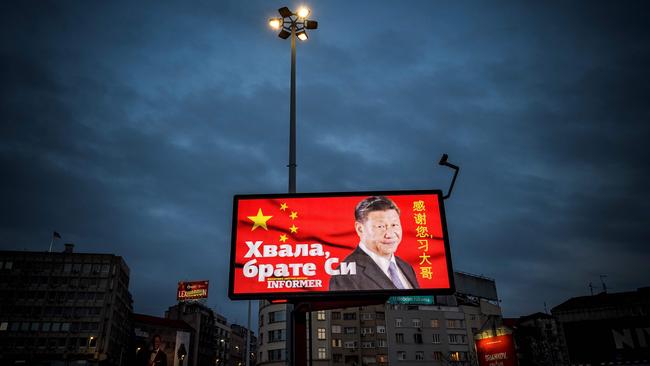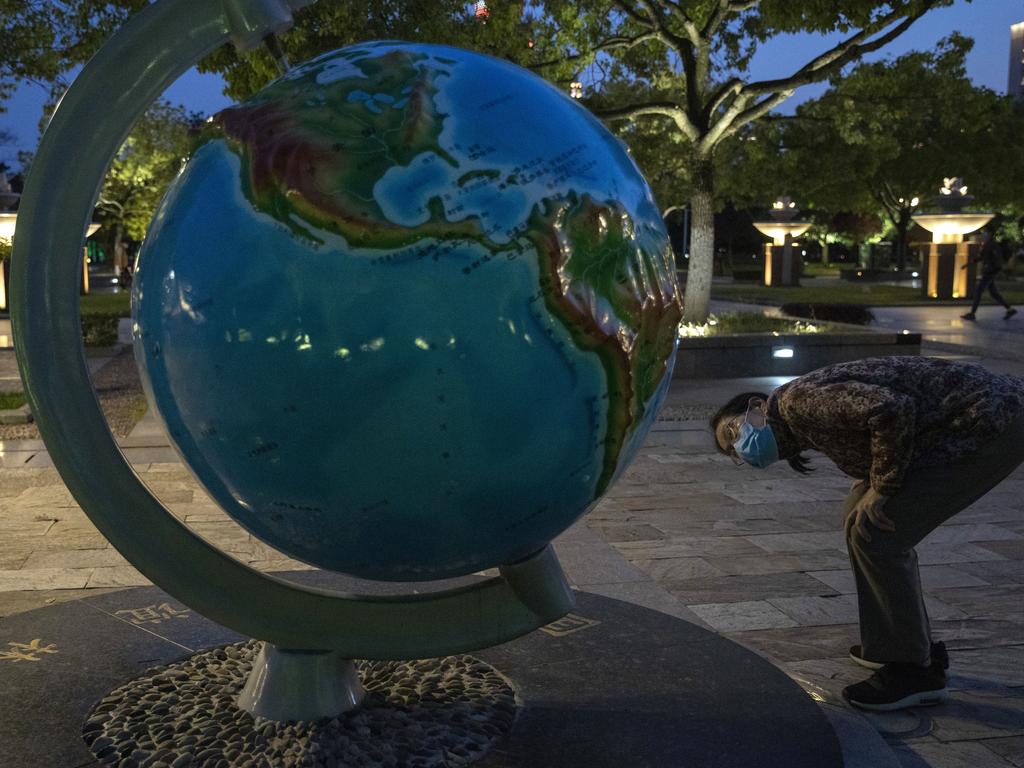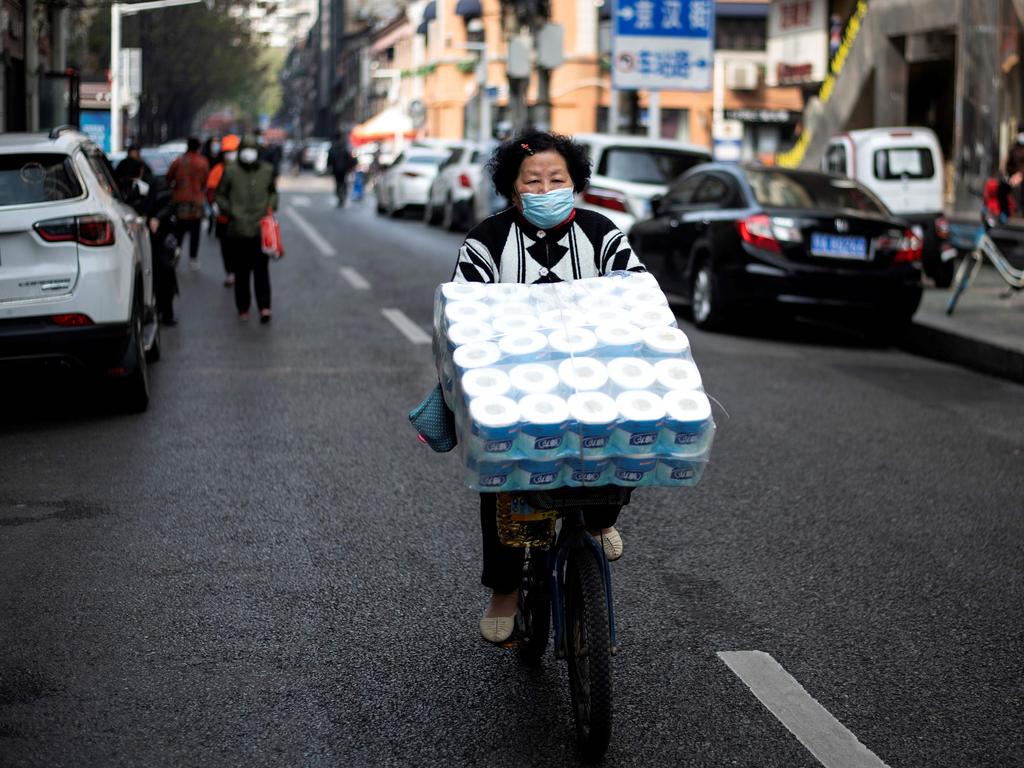Coronavirus: China wants to be saviour of the world
With the US dangerously incapacitated by COVID-19, Xi Jinping is seeking to seize a major strategic advantage.

The core of the security problem is the Chinese Communist Party’s determined drive to emerge from COVID-19 in a stronger strategic position in the Asia-Pacific relative to the US and its allies. This is not just about diplomacy. The Chinese military is aggressively positioning around Taiwan, using ships and combat aircraft to push into Japanese and South Korean territory, and doing high-end combat training in the South China Sea.
At the same time Communist Party newspapers are pump-priming aggressive nationalism. The Global Times, the party’s English-language newspaper, editorialised on April 4: “If the Taiwan question leads to a China-US showdown, no matter what the results, Taiwan will pay an unbearable price. The world has entered an eventful period, during which Taiwan is ineligible to play an active role.”

Beijing’s sabre-rattling over Taiwan is hardly new, but in the first months of this year we have seen a significant stepping up of Chinese military activity and an intense propaganda effort to isolate Taiwan and assert political primacy in the region.
Forget the conspiracy theory that the coronavirus came from a People’s Liberation Army biological warfare laboratory. That’s fantasy. What is fact is that Beijing is using the virus to position itself as the saviour of much of the world, sending medical equipment and doctors, building political indebtedness and loudly claiming that authoritarianism is doing a better job of beating the virus than the US and many democracies.
This is why there is such an intense Communist Party push to win the narrative battle and why there is such hostility to self-evident judgments that the virus originated in China and that the party hid the seriousness of the crisis in January while Chinese companies stripped Western countries of protective medical equipment.
Here is a practical example: Greenland Australia, a Sydney-based Chinese-owned property development company, has admitted that “in late January and early February” it was directed by its Shanghai-based parent to buy and ship huge quantities of medical supplies from Australia to China.
While this was happening Chinese Foreign Minister Wang Yi spoke with Australian Foreign Minister Marise Payne on January 30. Wang Yi told Payne: “The epidemic is generally preventable, controllable and curable.” On February 13, the Chinese embassy in Canberra was expressing “deep regret and dissatisfaction” over Australian restrictions on travel from China, saying these were “extreme measures, which are over-reaction indeed”.
The Communist Party’s handling of the crisis has been to extract maximum advantage for itself at the expense of every other country in the world.
The Global Times reported that People’s Liberation Army combat aircraft for the first time conducted night-time combat drills southwest of Taiwan on March 16. The paper said “similar drills are expected to become more frequent in order to let Taiwan secessionists get a clear idea of the power gap between the mainland and the island”.
On March 20, a Chinese fishing boat collided with the Japanese Self Defence Force destroyer Shimakaze in the East China Sea. Japan claimed the incident occurred on the high seas (international waters) while Beijing said it was in Chinese coastal waters.
On March 26, South Korean jets were scrambled to intercept PLA surveillance aircraft that flew into Korean-claimed airspace.
In the South China Sea in the middle of last month, the PLA’s first aircraft carrier, the Liaoning, conducted flight training, according to the PLA Daily newspaper: “Training for war preparedness will not be stopped even in the middle of the COVID-19 epidemic, and the training of carrier-based fighter pilots must continue.”
The Liaoning is still operating in the South China Sea. For its part the US Navy last week sent a guided missile destroyer, the USS Barry, through the Taiwan Strait — a measure intensely disliked by Beijing — and amphibious assault ship the USS America exercised with Japanese warship Akebono.
This heightened level of military exercising has gone largely unnoticed because of COVID-19. While it is not unprecedented, at this time of international crisis there is a risk that the PLA’s posturing could spark a conflict.
Beijing’s increased military activities are meant to be seen as a show of strength and to contrast with the challenges the US Navy is facing with maintaining a viable presence in the western Pacific — aircraft carrier the USS Theodore Roosevelt is tied up in Guam, with COVID-19 having infected many personnel.
China claims that crew on three other American aircraft carriers have faced COVID-19 outbreaks and that there is no viable US carrier presence in the Pacific.
It’s unlikely the PLA has been able to avoid some infection with COVID-19, particularly among those soldiers used as first responders in Wuhan, but by not revealing the early stages of the crisis China has had more time to quarantine elite units.
Beijing is clearly showing it can operate forces around the so-called first island chain including Japan, Taiwan and maritime Southeast Asia.
How might this play out across the rest of this year and into next year? I anticipate a dangerous situation arising over Taiwan as Xi Jinping seeks to seize a strategic advantage while the US remains dangerously incapacitated.
A scenario could look like this: Xi has shaped his premiership around preparing for two critical centenaries. The 100th anniversary of the founding of the CCP is on July 21 next year, at which time Xi’s aspiration is for China to be “moderately well off”. By October 2049, the centenary of the party’s takeover of power, China is to be a “strong democratic, civilised, harmonious and modern socialist country”.
Xi won’t be around in 2049 but he will steer the party through the first anniversary. COVID-19’s effect will be to damage the aspiration for being moderately well off. Xi may calculate that this is a moment to harness Chinese nationalism by focusing the population on a campaign to retake Taiwan.
Militarily, the calculation may be that the US is distracted by COVID-19, Donald Trump’s failure to manage it, and a presidential election campaign.
With the virus reducing Western military effectiveness, there may not be a better time for the PLA to blockade the Taiwan Strait and squeeze Taipei economically. Taiwan is now a successful liberal democracy. It has shown how to manage a COVID-19 lockdown without resorting to the repressive measures seen in Wuhan.
The Taiwanese have never seemed less inclined to support so-called unification with the mainland. Being a different and successful model of political organisation, Taiwan profoundly threatens Xi’s personal leadership and the credibility of the Communist Party.
A crisis over the Taiwan Strait would instantly push the region into a dangerous cold-war situation, one that would be the ultimate test of US credibility as a Pacific power, and would be existentially threatening to Taiwan and Japan. There would be no guarantees that a blockade wouldn’t slide into major and sustained conflict, drawing in the US and its allies.
A pre-emptive effort to coerce Taiwan would be immensely risky for Xi, but leaders under pressure do risky things and there is a long history of Beijing pushing the limits of regional tolerance — island-building in the South China Sea — to see what it can get away with.
The challenge for Washington, Canberra and other allies and partners is to ensure Xi calculates that this is a risk not worth taking.
What should Australia do? First, Scott Morrison needs to be talking with Trump, Shinzo Abe, Joko Widodo, a recovered Boris Johnson and any other national leader who is willing to join a co-ordinated pushback against PRC military opportunism.
This is a tough call. Canberra’s deepest instinct is to say nothing and hope all will return to justin-time normalcy. That won’t happen. COVID-19 exposes the real nature of the Communist Party, which cannot be accommodated by an Australia that’s needing to build up practical sovereign capabilities for our national security.
Second, far from thinking that this is a time to cut defence spending, the government needs to double down on strengthening the Australian Defence Force, including by urgently building up munition and fuel stocks to have the force as operationally ready as it can be.
Australia is going to be deeply in debt, but we don’t have to be in debt and unsecure. Now is the time to be investing in nation-building, sovereignty-enhancing defence capabilities.
A defence budget that was closer to the US’s 3.2 per cent of gross domestic product rather than just under 2 per cent would be a more realistic base to handle the strategic risks we face.
Third, it’s time for new thinking about our national security challenges. For unworthy bureaucratic reasons we did away with a national security adviser years ago and haven’t seen a national security strategy since Julia Gillard produced a flabbergasting document in January 2013 that said Australia faced a “positive” and “benign” security outlook.
Fourth, a new defence white paper needs to be commissioned soon. At minister Linda Reynolds’s direction, the Department of Defence has been working on a strategic update and review of procurement plans.
But this was before COVID-19. The need will be for something dramatically bigger and produced much faster than the 2016 white paper, which took two years to develop — the same time it took China to build three air bases in the South China Sea.
Finally, the Prime Minister has wisely realised that COVID-19 will force Australia to redesign its approach to supply chain security. A stronger national security perspective must be brought to how we manage fuel security, food, medical supplies, information technology and critical infrastructure. This will unseat many comfortable Canberra assumptions, but there is no return to the pre-COVID-19 world.
COVID-19 is changing everything, turbocharging the strategic trends that were already making the Indo-Pacific region a riskier place. The reality of China’s threat to regional security is undeniable. Now we must prepare for the crisis after the crisis.
Peter Jennings is executive director of the Australian Strategic Policy Institute and a former deputy secretary for strategy in the Defence Department.








The global economy may be in hibernation but geopolitics is thriving and sprinting towards a potential crisis towards the end of this year and early next year. The immediate and understandable focus is on fighting the coronavirus pandemic, but our government must be thinking about defence and national security risks as well.